James Marsden, Russell Brand Hop
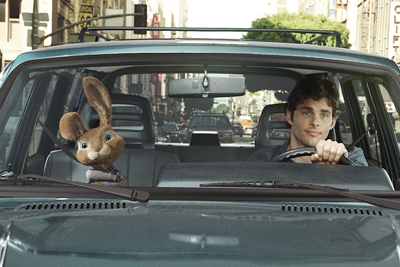
Hop
Cast: James Marsden, Russell Brand, Kaley Cuoco, Hank Azaria, Elizabeth Perkins, Gary Cole, David Hasselhoff, Chelsea Handler, Hugh LaurieDirector: Tim Hill
Genre: Animation, Action, Comedy
Synopsis: Blending state of the art animation with live action, Hop is a comedy about E.B. (voiced by Russell Brand), the teenage son of the Easter Bunny.
On the eve of taking over the family business, E.B. leaves for Hollywood in pursuit of his dream of becoming a drummer. He encounters Fred (James Marsden), an out-of-work slacker with his own lofty goals, who accidentally hits E.B. with his car.
Feigning injury, E.B. manipulates Fred into providing him shelter, and Fred finds himself with the world's worst houseguest.
Release Date: 7th of April, 2011
Website: www.hopthemovie.com.au
Prior to founding Illumination, Chris Meledandri spent 13 years at FOX where he oversaw the studio's animation division and the launch of blockbusters such as the Ice Age franchise. "We have this incredible opportunity, whether we're working exclusively in animation, or we're combining live action with animation, to write, design and animate rich, endearing and, hopefully, enduring characters," quotes Chris Meledandri.
Chris Meledandri commissioned Cinco Paul and Ken Daurio (with whom he had worked on Horton Hears a Who! and Despicable Me) to develop the idea based on a concept by Illumination executive John Cohen.
Together with Brian Lynch, Cinco Paul and Ken Daurio created the fantastic story of E.B., the teenage son of the Easter Bunny who has no interest in his birthright. In the tiny region of Rapa Nui (Easter Island), E.B. has been raised with the expectation that he would one day inherit his dad's job. But all he wants to do is drum in a band and see the world that exists outside of his tiny island.
Halfway across the world, we meet Fred O'Hare, a 30-year-old who, though talented, has bounced from job to job-unable to find a career that is right for him. Meeting an unexpected houseguest in E.B. ironically proves to be the exact thing he needs to jumpstart his life.
Chris Meledandri walks us through E.B.'s introduction: "On the eve of the power of Easter being passed to him by his father, E.B. is about 17 years old…in human years. He decides that it's not for him but when he tries to tell his dad, his dad won't listen. E.B. decides to split, leaving Easter in the lurch as he goes to Los Angeles where he pursues a career as a drummer. He ends up becoming the most unruly roommate of Fred O'Hare. Ultimately, they're both characters who are struggling with the transition from adolescence into adulthood."
To give these characters a rich world in which to play, the writers created an innovative, imaginative back-story for the Easter Bunny and his kind, in which everything we've ever assumed about the spring holiday is explained. Notes John Cohen: "The world of Easter has never before been brought to life on film. By answering questions like 'Where is all this candy made, who paints the eggs and how does the Easter Bunny travel from town to town?' our writers and design team created an entire world and new mythology located on Easter Island. It's a charming and fantastical factory run by bunnies and chicks where candy is manufactured and put into baskets, around the clock, in preparation for Easter."
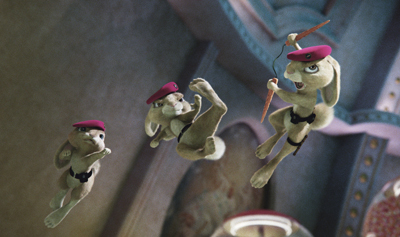 When considering who would helm the follow-up project to his company's first film, Chris Meledandri returned to a director whom he'd met during his time as president of 20th Century Fox Animation, Tim Hill. Chris Meledandri liked the fact that Tim Hill would be joining an expanded team whose approach to making live-action movies is so influenced by their experience in animation. He recounts: "We had a great experience with Tim Hill, having developed Alvin and the Chipmunks with him and had been looking for an opportunity to work together again."
When considering who would helm the follow-up project to his company's first film, Chris Meledandri returned to a director whom he'd met during his time as president of 20th Century Fox Animation, Tim Hill. Chris Meledandri liked the fact that Tim Hill would be joining an expanded team whose approach to making live-action movies is so influenced by their experience in animation. He recounts: "We had a great experience with Tim Hill, having developed Alvin and the Chipmunks with him and had been looking for an opportunity to work together again." "Tim Hill showed such amazing abilities as a comedy director on the first Alvin film," Imperato Stabile adds. "He is equally comfortable and skilled at directing human characters as he is at directing animal ones. His deep knowledge of the challenges and nuances-both technically and artistically-of blending live action with state-of-the-art CG animation has provided a daily education to those of us who are lucky enough to work with him."
Tim Hill agreed to come onboard, primarily because Illumination shared his vision of not "simply making a kids' movie." He provides: "I never make movies for kids. I make them for me. To work, the sensibility and the tone have to be that of a comedy for any audience. On a comic level, the humor has to be more sophisticated than in most kid movies."
In addition to the humor he found in Cinco Paul, Ken Daurio and Brian Lynch's screenplay, Tim Hill believed that audiences would appreciate that for the first time, filmmakers were creating a cinematic treatment of a huge holiday. He notes: "No one's really done a big film about the Easter Bunny. I think that audiences will respond to this character who is so beautifully animated. He's cute, and he's got a lot of character.
"I believe Hop will play any time of the year and for any audience," Tim Hill continues. "We've created a piece of entertainment that's based around that time of year, and around a character that's associated with a myth…but it does play for all seasons. Hop is universal, because the story's universal."
Down the Rabbit Hole: The Look of Easter World
Hop takes place in two very different locations: Los Angeles, where Fred spends his time daydreaming, and the fantastical world of the Easter Island candy factory. To imagine Easter World, the filmmakers recruited a team that was supervised by production designer Richard Holland, with whom Tim Hill had worked closely on Alvin and the Chipmunks.
This candy factory run by the Easter Bunny is a world unlike anything ever imagined. An enormous factory that cranks out gumballs of every color and where colorful cascades of jelly beans crash as waterfalls, the Easter Bunny's warehouse creates treats for every person's palette. You'll find chicks and bunnies working together to monitor the production of marshmallow candies and conducting quality control on the vats of glistening milk chocolate in this wonder world of Easter.
On the night before Easter, the Easter Bunny loads these decadent treats into a large egg-shaped sleigh that's drawn by a team of flying chicks. Santa's more widely known reindeer-led sleigh was actually inspired by the Easter chicks. Only the one anointed Easter Bunny can navigate the dark, swirling vortex of rabbit holes to travel across the world in 24 hours.
Chris Meledandri explains the look of Easter World: "When you approach one of the monolithic Easter Island heads, the mouth opens and an elevator appears. It transports you underground to our magnificent candy factory. Our team has designed an imaginative environment that will delight audiences of all ages: a production facility filled with chocolate, bunny mold-making machines and lots of Easter baskets being filled. You'll find candy-funneling machines, candy chutes and rabbit-shaped 'oil' rigs that pump chocolate. It's all being done by these hilarious little yellow chicks and adorable bunnies."
Imperato Stabile shares how it's possible for this team to make this world look so incredibly detailed. "Tim Hill and the animators have systematically and carefully created all the characters that live and work in this space…all digitally," she relays. "They've painstakingly ensured that the clothing and the fur look real…but they're a bit exaggerated. They made them just a little bit bigger than normal-sized rabbits and chicks so it's easier to see their expressions as they play off one another."
The Players of Hop
This handy guide will illuminate the rabbit, chick and human players who populate the Hop universe.
Fred (James Marsden) is a 30-year-old trying to pull his life together. When he was a little boy, he woke up early on Easter morning, looked out his window and witnessed E.B.'s dad delivering his basket. When Fred told his family and friends of his discovery, they said he was dreaming, even crazy. Flash forward to present day…and we meet a directionless guy who knows he's destined for something. Once he meets E.B., Fred doesn't care if he's a talking rabbit who poops jelly beans, he knows he can take the job his friend has eschewed. If E.B. can be a drummer, why can't Fred be the Easter Bunny? With a little training he'll be ready to pick up the Egg of Destiny-a golden scepter adorned with a golden egg that will give Fred the powers of the Easter Bunny.
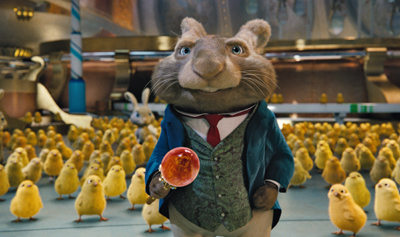 The Easter Bunny's son, E.B. (Russell Brand) has been groomed since birth to take over the family business. Years of sitting through egg-painting classes and candy-production tutorials, as well as honing his lightning-fast reflexes have all led up to the day he is supposed to claim his birthright. But since he was a baby bunny thumping on his bongos, all E.B. has ever wanted was to become a drummer. Hours before his coronation (when he's to inherit the mantle of the Easter Bunny) he flees Easter Island for L.A. to pursue his dreams.
The Easter Bunny's son, E.B. (Russell Brand) has been groomed since birth to take over the family business. Years of sitting through egg-painting classes and candy-production tutorials, as well as honing his lightning-fast reflexes have all led up to the day he is supposed to claim his birthright. But since he was a baby bunny thumping on his bongos, all E.B. has ever wanted was to become a drummer. Hours before his coronation (when he's to inherit the mantle of the Easter Bunny) he flees Easter Island for L.A. to pursue his dreams. Sam O'Hare (Kaley Cuoco) is Fred's younger sister. Though only in her mid-twenties, Sam is a driven professional who desperately wants Fred to get his act together. Probably against her better judgment, she sets him up on a job interview with a video-game company…as well as at a housesitting gig at her boss' mansion. Sam is optimistic about her big brother and knows he is on the cusp of rebooting his life.
Every year, on one magical night in spring, one fabled rabbit is responsible for the delivery of glorious eggs and delicious candy to the children of the world. E.B.'s dad, the Easter Bunny (Hugh Laurie) , is that legendary hare. The rest of the year he oversees candy production, egg dyeing and the legions of chick and bunny workers. On the eve of his retirement, he's ready to pass the mantle to his son, E.B. There's only one hitch: E.B. doesn't want the job. When he realises his son has run away, his fatherly instincts prevail and he sends his royal guard to rescue his only son.
Carlos (Hank Azaria) , the Easter Bunny's right-hand chick, often accompanies the Easter Bunny on tours of the candy factory. Firm, tough, and far too large to be a chick, Carlos is all business. Frustrated by the sovereignty of the Easter Bunny and his team of rabbits, Carlos has been serving as No. 2 for years. But Carlos is sick of playing second fiddle. After all, Easter is all about eggs, so why shouldn't chickens be in charge? He has been plotting a coup d'état and wants to replace candy with the more fowl-acceptable birdseed, worms and lettuce cups. This year, with the disappearance of E.B., Carlos has his chance…and a sneaky plan up his wing.
Just as every general requires disciplined soldiers, the Easter Bunny needs unflappably loyal chicks to make Easter happen. They have to be hardworking, they need to be committed and they need to be the best. Phil (Hank Azaria) isn't any of those, but somehow he got the job anyway. Phil couldn't be happier. He gets to make candy, hang out with a thousand chicks, take naps when no one is looking and loves to dance-life is pretty awesome. Though an extremely enthusiastic worker chick, Phil isn't the brightest crayon in the box.
Don't be fooled by their adorable name. The Easter Bunny's royal guard, The Pink Berets, are trained professionals. They have the training, they have the tools, they also have the adorable pink hats. These silent bunnies mean business, but they are only to be used in cases of extreme emergency. When E.B. goes missing, this SWAT team is sent to bring him back. They'll get their man, and nothing will stand in their way. Fluffy is the leader and the most skilled huntress who carries her tracking device. Patch is the weapons expert who has a furry patch over her left eye and always has blow darts handy. Bit is the baby sister who tries her hardest to keep up but often messes up missions for the trio. You'll never find her without an inhaler to help with her asthma. The Pink Berets relentlessly pursue E.B. through Hollywood trying to bring him back to Easter Island.
Fred's father, Henry O'Hare (Gary Cole) , is a family man who is extremely proud of two of his three children-the other one needs a big, hard shove out of the nest. Mr. O'Hare just wants to see his son stand up on his own two feet and settle for a boring job that will pay the bills.
Fred's mother, Bonnie O'Hare (Elizabeth Perkins) , is a classic maternal figure and the peacemaker in the family. She doesn't quite understand her son, but she still wants the best for him. Always supportive of her kids, she tries to put a positive spin on any situation.
Alex (Tiffany Espensen) is Fred's 10-year-old adopted little sister. Just like Sam, Alex is an overachiever who can beat Fred at anything. Alex playfully tells her older brother that she thinks their family adopted her because Fred is such a disappointment. She is so talented that she has been cast as Peter Cottontail, the lead role in her school's Easter play. Just keep your ears alert for an unexpected version of "I Want Candy" at Alex's play.
Angelenos and Easter Islanders: Casting the Comedy
When casting the talent for Hop, the production team knew it needed to bring characters to life that had rich comedic personalities-whether they be animated or live-action ones. In the buddy comedy, the two pals happen to be a rabbit and a human being whose lives intersect at a moment when both are experiencing big changes. The entertainment of this film centers on the comedic interaction of these newfound friends.
Cast as Fred O'Hare, a 30-year-old slacker who still lives at home, was actor James Marsden. Not only has the performer been a staple of the X-Men series in the past decade, his standout turns in Enchanted and Hairspray have familiarised audiences with his sharp comedic timing. Says director Tim Hill: "I was excited about casting James Marsden because he's not only funny but he's a grounded actor. He always wants to know where the truth is about the character and where it's coming from. We talked about the bunny as being super real so that James Marsden's performance could be modulated to match that, and he could still react to E.B. in a very comic way."
Chris Meledandri was impressed with James Marsden's work opposite a co-star that had to be animated in postproduction. "James Marsden is a wonderful actor. He has an incredibly expressive face, and it's a perfect complement to an animated character. You saw it in Enchanted, where he played someone who actually was the embodiment of an animated character coming to life. He is a great actor to partner with."
Both the cast participating in Hop and the chance to work with Illumination were selling points for James Marsden. "I knew that Russell Brand was onboard," says the actor. "He's very smart and he lends a specific sharp, comic edge to the movie. I wanted to be included in that company. I also think the guys at Illumination are tremendously talented. I have two children who would love to see this movie, so I'd be lying if I said that wasn't a reason why I wanted to do this. Plus, Tim Hill's a terrific director who is definitely in his wheelhouse and excited about doing something special. He's incredibly inventive and great with the actors."
Just as E.B. believes Fred gives off an aura of untapped potential, James Marsden found a number of redeeming qualities to Fred. He states: "I admire Fred because he's not backing down from his dream, whatever that dream is. I don't know that he's able to define it at first, but he knows what it's not. He's also kept a pretty good sense of humor about it. He's not, by any means, a loser. He feels that there's something more special for him out there that he has to go and look for."
Paired opposite James Marsden is British comic actor Russell Brand, who voices E.B. Explains producer Chris Meledandri: "This is our second time working with Russell Brand. He did a wonderful supporting voice in Despicable Me as Dr. Nefario. In Hop, he is front and center. The minute that Russell Brand starts performing, he imbues the character with rich, comedic personality that gives the animators so much to work with. He has a level of energy that almost cannot be contained. It is explosive and comedic, but perhaps most importantly for this film is that his voice embodies sweetness."
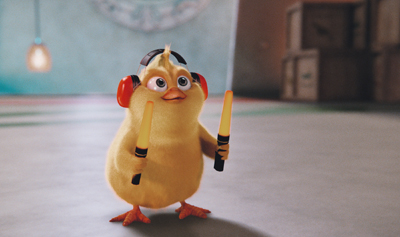 Both E.B. and Fred have severely disappointed their dads, and both just want them to be proud. Director Tim Hill discusses how Russell Brand was able to walk the line of humor and drama. "Russell Brand brings a lot of edge to the character, but he's also very empathetic," commends Tim Hill. "He has a great range and can play the impish part of E.B., which is the part that gets to Fred. E.B. is also a rock 'n' roll kid, and Russell Brand can play it that way, which is a great advantage for us. He's dry and funny and a little crazy, and that's how I think a lot of teenagers can be."
Both E.B. and Fred have severely disappointed their dads, and both just want them to be proud. Director Tim Hill discusses how Russell Brand was able to walk the line of humor and drama. "Russell Brand brings a lot of edge to the character, but he's also very empathetic," commends Tim Hill. "He has a great range and can play the impish part of E.B., which is the part that gets to Fred. E.B. is also a rock 'n' roll kid, and Russell Brand can play it that way, which is a great advantage for us. He's dry and funny and a little crazy, and that's how I think a lot of teenagers can be." For his part, Russell Brand looked forward to reuniting with the filmmakers at Illumination. He says: "I was in Despicable Me, in which I played the voice of an old person. When Dr. Nefario said something, I'd step in and do it. I thought the film was really funny and loved Steve Carell in it. The filmmakers asked me if I wanted to be in another film in which I was the Easter Rabbit. I thought that would be brilliant fun, and it's been a thrilling experience."
Providing the vocals for a character with big dreams also appealed to the kid within the performer. "I was attracted to the role of E.B. because I thought I would get to be a mischievous rabbit without having to move around," laughs Russell Brand. "Turns out it was very difficult to provide the voice of an animated character; it takes ages."
Two weeks prior to the start of the live-action shoot, James Marsden sat in on Russell Brand's recording sessions and read opposite him. "I found that extremely helpful," James Marsden explains of working with the voice that would end up in his backpack. "I requested to sit in on some of Russell Brand's dialogue sessions so that he and I could feel what our dynamic was. I wanted to hear him saying the lines so that it would inform me of how to respond. I read opposite him just to feel what it would feel like when the movie's done."
During the recording sessions in which James Marsden wasn't in the room with him, Russell Brand didn't worry about not having a fellow performer with whom to interact as "acting is all about make believe anyway," he says. "Sometimes, I imagined I was doing the whole scene in a racecar, just to add an element of thrill to keep it even more exciting."
In the role of Fred's much more successful younger sibling, Sam, is Kaley Cuoco of CBS' hit comedy The Big Bang Theory. "Kaley Cuoco is amazing because she's very real," says Tim Hill. "She's naturally very funny so there's not a lot you have to do with her; she just gets it very quickly. Sam mothers Fred a little bit, but he needs it and she's been fantastic as the character."
"She's actually Fred's buddy; she just wants to help," reflects the actress. "She's trying to help him get a job, and she tries to support all these wacky things he does because she's successful on her own. She's got her life much more situated than Fred." Discussing her rationale for joining the project, Kaley Cuoco adds: "I've been doing television for so long, and I thought film would be a fun change. I also love that there is an animated component to Hop."
The filmmakers cast The Simpsons' Hank Azaria, who has voiced animated characters for more than two decades, as Hop's principal chicks: the duplicitous, oversized Carlos and the easygoing, somewhat simple Phil. The performer's working relationship with Chris Meledandri extends back to 1997, when Azaria voiced the part of the bat Bartok in the animated film Anastasia. Chris Meledandri discusses the team's choice to provide vocals for Carlos and Phil: "Hank Azaria has an unparalleled ability to provide signature voices to his characters that are simultaneously distinct and express a unique comedic personality. The minute we heard Hank Azaria's vocals for these two chicks, we were charmed."
Hank Azaria laughs: "I was drawn to Carlos and Phil because it's not every day you get to play a chick, especially a dominating, angry one like Carlos. He's a funny little villain." Discussing his process, the performer compares voice work to acting in front of a camera: "Though there's no body language in voicing animation, ironically, in order to do the voices properly, you need to physically act them out. In a sense, there isn't a huge difference between the two. You need to commit as fully to the performance as if you were on camera. But you can't only act from your voice; you have to do the whole thing. You almost overdo it so that it's sold in your vocal inflection."
To get into Phil mode, Hank Azaria recalls that he made his voice go as cute and high as it could. He appreciated that director Tim Hill "encouraged a lot of the weirdness." States the actor: "Phil is just a happy guy. He's very mellow, insightful, does his job and enjoys it. He also really loves to dance. But I think Phil knows more than he says. He may even be playing dumb a little bit…"
Cast as Fred's parents, Henry and Bonnie O'Hare, were comedic actor Gary Cole, well known for his hilarious portrayal of patriarch Mike Brady in The Brady Bunch films and his classic work on Office Space, and actress Elizabeth Perkins, a longtime favorite on Showtime's hit series Weeds. Shares Chris Meledandri of the O'Hares: "Fred's mother is the peacemaker in the family. She doesn't quite understand her son but she's trying to be the balance to Fred's hard-driving dad-whose confusion about why his son hasn't already demonstrated professional success comes across as being a bit tough. Mrs. O'Hare tries to balance that and make sure that the family dynamics don't implode."
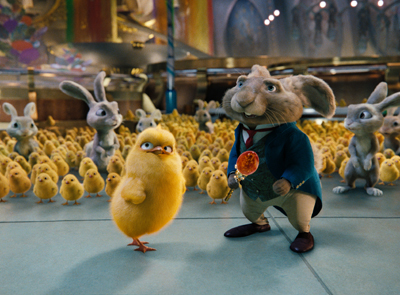 Says Elizabeth Perkins, who has known and worked with her on-screen husband since she was a teenager: "My character is the eternal optimist. Somewhere inside, she still believes in fairy godmothers, Santa Claus and the Easter Bunny. So she's always very supportive of whatever is going on in her son's life, even if he's still living at home. What I loved about this script is that it is hopeful, and it has positive messages. It's about having faith in things that you don't see or hear or can't prove exist."
Says Elizabeth Perkins, who has known and worked with her on-screen husband since she was a teenager: "My character is the eternal optimist. Somewhere inside, she still believes in fairy godmothers, Santa Claus and the Easter Bunny. So she's always very supportive of whatever is going on in her son's life, even if he's still living at home. What I loved about this script is that it is hopeful, and it has positive messages. It's about having faith in things that you don't see or hear or can't prove exist." Playing the heavy in the O'Hare family was an enjoyable experience for Gary Cole. Of his role as Henry O'Hare, he explains: "As the movie opens, my character is not very thrilled with Fred's career choice, or anything about him actually. He's trying to be tolerant, but he isn't. Even when Fred arrives at a new job with some enthusiasm, my character is a little skeptical…to say the least."
Mr. O'Hare isn't the only disappointed patriarch in the comedy. Explains Chris Meledandri of E.B.'s father's back-story: "The Easter Bunny is in many respects a true traditionalist. He comes from a long line of Easter Bunnies stretching back thousands of years. He loves his son very much and has high expectations for him."
For the role of the Easter Bunny, Tim Hill and the producers selected award-winning actor Hugh Laurie. Hugh Laurie appreciated the theme of the film and was keen to provide voice work. Though he plays an eccentric character on FOX's drama House M.D., Laurie actually has a comedic background. Says the actor: "I thought it was a charming tale of a young man deciding what he wants to do with his life and what's important in the world. What people can do with rhythm and with the expressiveness of their voices are things that I've always found absolutely fascinating. I loved the challenge of it."
When it came to his recording sessions, Hugh Laurie was game occasionally to ad lib takes for Tim Hill. "I usually wouldn't substitute for something that's there, but I like to try and add because the audience is very quick to detect the life and spontaneity in something that happens by accident," he states. "There are certain moments that are difficult to render on a page, and so the writers tend not to write them. It's important to keep alive the spontaneity of things."
Making cameo appearances in Hop are several unexpected guests, including comedian, talk-show host and author Chelsea Handler. As Mrs. Beck, Chelsea Handler interviews Fred for a potential job at a video-game company. Unfortunately for Fred, E.B. sneaks into the job interview and causes mischief around the office…making it tough for Fred to make a good impression on Mrs. Beck. Known for her dry sense of humor, Chelsea Handler describes her character as "very similar to me, except she wears a suit and I don't; it's a bit of a variation from what I'm normally associated with."
Says James Marsden about working with Chelsea Handler: "It was great, that is, when we could keep it together. I've been doing this for 16, 17 years and maybe three or four times I've been in situations where you just can't get through a take because you're laughing so hard. Chelsea Handler's relentless and fearless and made fun of me throughout the whole week."
While Fred is interviewing with Mrs. Beck, E.B. stumbles upon a jam session that's occurring in the studios. Just as E.B. hops past, the living legends of gospel known as The Blind Boys of Alabama-comprised of Jimmy Lee Carter, Billy Bowers, Benjamin Moore Jr., Eric Dwight McKinnie, Joey Anthony Williams, Tracy Roman Pierce and Will Cleveland Smith-are recording a song for the game "Extreme Blues Master." E.B. is able to sneak in on the recording session with the five-time Grammy Award winners and play drums with the band.
In turn, the group hands E.B. a pamphlet for a talent show hosted by a man they consider the "godfather of entertainment." Hoff Knows Talent is looking for new acts, and the eponymous host is none other than…David Hasselhoff.
David Hasselhoff knows talent, and this rabbit's got it. In the comedy, David Hasselhoff isn't fazed by a talking bunny, much less one who knows how to wail on the drums, and is quite impressed with E.B.'s percussion skills. After E.B. auditions for Hoff Knows Talent, he is invited back to perform on the live show. When E.B. expresses doubts about appearing during a time when his friends and family need him, it is Hasselhoff who convinces E.B. to follow his heart.
E.B. Joins Our World: Blending CGI With Live Action
Unlike wholly animated films, the construction of a CG/live-action comedy logically requires that the drawn creatures have many interactions with humans, as well as play in a world all their own. For Hop, those requirements meant executing the enormous challenges of constructing a true-to-life rabbit that would look as real interacting with friends and family on Easter Island as he would harassing the people of Fred's world. Visual effects shop Rhythm and Hues (R&H) was given this Herculean task, and it would require an army of animators under the direction of Hill and VFX supervisor Raymond Chen to provide a seamless experience for the audience.
Designing E.B.
The signature characters of E.B., the Easter Bunny, Carlos and Phil were designed by Emmy Award-winning and Annie-nominated artist Peter DeSève, whose relationship with Chris Meledandri extends back to their work together on the Ice Age films, for which Peter DeSève designed the scene-stealing saber-toothed prehistoric squirrel known to tens of millions as Scrat. Commends Chris Meledandri: "Peter DeSève's unique touch at creating timeless characters is inimitable. We knew our hero had to be irreverent, fun, hip, young and a classic character, and Peter DeSève nailed the design for E.B., the Easter Bunny and our two main chicks."
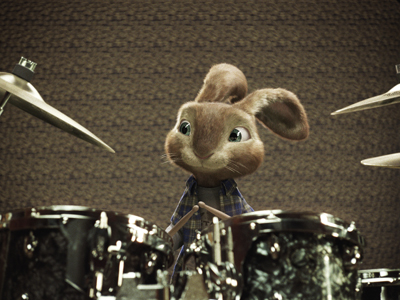 In order for Peter DeSève and the animators to bring E.B. to life, they began to conceive the character by studying Russell Brand's vocal performance. Footage of Russell Brand reading E.B.'s lines was recorded, and the artists used his facial expressions, movements and eccentricities as reference points to build E.B. The goal was to create a character that was all bunny, but also one who had the attitude of a teenager ready to make his way out into the world.
In order for Peter DeSève and the animators to bring E.B. to life, they began to conceive the character by studying Russell Brand's vocal performance. Footage of Russell Brand reading E.B.'s lines was recorded, and the artists used his facial expressions, movements and eccentricities as reference points to build E.B. The goal was to create a character that was all bunny, but also one who had the attitude of a teenager ready to make his way out into the world. When not leading the storyboarding stage or designing Young E.B., animation supervisor Chris Bailey (in his third collaboration with Tim Hill) spent a great deal of time with his team blending Russell Brand's recorded performance with the body language and mannerisms of a teenager. Next, the animators took video reference of themselves acting out the performance and reading the lines. This allowed them to capture other physical characteristics needed to animate E.B., and pace the timing as he moved through each scene from the storyboards. As they drew E.B., they would also incorporate specific animal characteristics, such as the wiggling of a rabbit's nose as it sniffs or the quick movements of a bunny's hind leg when it scratches an itch.
For a period of time, with the number of bunnies and chicks that were surrounding its animators as they worked, R&H resembled a petting zoo. Whether capturing motions of the bunnies' ears as they stood at attention or of the chicks peeping loudly and fluffing themselves with their quick, jerky moments, dozens of cameras were trained on the adorable animals to ensure that a 360-degree take was achieved.
Because it was crucial to make it seem as if E.B. and his family and friends were interacting with humans, a great deal of attention had to be paid to fur styles. When E.B. was picked up or physically "on" an actor, his fur condition and quality (e.g., matting, flattening) would change. Style, color and flexible textures were particularly belabored upon until Tim Hill and his team found just the right look for each of the creatures.
Raymond Chen shares more of their process: "E.B. is an original character with a long history. He's not a character that was transferred from another medium. It's been great to see the animators and the artists bring their own ideas of what he should be-how he should perform, what sort of attitudes he has. The question as to whether E.B. is more Russell Brand or more of an actual bunny is something that we balanced from scene to scene. In some cases, we followed either video reference or listened closely to dialogue to try to figure out how many Russell Brand mannerisms we should get into the shot. In others, it was about trying to convey the attitude of this little animal."
The artists began each sequence of animation with storyboards that described the particular scene. To digitally create the CG character of E.B., they went through a build process in which they modeled the character in a neutral pose. States Raymond Chen: "We then put in a rig to allow E.B. to move-to get his facial expressions correct and allow him to move his limbs. On top of all that, we have his clothing: his T-shirt and his flannel shirt. For this, we ran cloth simulations to have it look like his clothes were moving like real pieces of cloth."
E.B. Interacts on Set
During production, Chris Bailey actually became E.B., serving as a double for the bunny when that was needed on set. Walking around with a 22-inch stuffed animal-the same height as the animated E.B.-as reference during rehearsals, he worked alongside the actors, Tim Hill, cinematographer Peter Lyons Collister and key crew to perfect the staging and pacing. Chris Bailey's performance as E.B. also helped to communicate to the team the physical sense of humor that the animators would ultimately bring to the rabbit voiced by Russell Brand.
The aptly named "Stuffy Pass," which included Chris Bailey and his stuffed animal, provided the actors with visual reference. This ensured that they would know where their eyeline should remain throughout the course of each scene they had with the rabbit. This also allowed the animators to note how E.B.'s form worked in the set's lighting. For example, though the stuffed animal only vaguely resembled the final E.B., it provided the R&H team an idea of how much light would hit the side of his face or roll over his shoulder as he turned.
"The stuffed animal was a terrific prop for our actors to act with in the rehearsal and to understand what the scene would be when it was actually shot," explains Chris Bailey. "During the actual shoot, we took the stuffed animal away and they were acting to nothing. For shots where E.B. walks in the front door and runs and hides behind a plant, the stuffed animal was more for the camera people to understand the timing. This helped them to know that he was at the door, then he was going to look for two seconds. Then he ran to the pot, peeked out from the other side, and then he ran over to another part of the room. They got their counts off of that."
Whenever E.B. needed to be held physically in a scene (e.g., bouncing out of Fred's arms or cuddling on Sam's shoulder) the actors would be given a beanbag that stood in for the mischievous bunny. This allowed the actors to have something to interact with and gave the artists an exact location of where E.B. should go in the shot. The beanbag ensured that the performers were holding their arms in the right way and that their hands were reacting in the correct manner. It also gave them a weighted reference, so their hands would be pulled down to the right level, as if they were actually holding a rabbit that was E.B.'s weight.
In order to get this digital interaction perfect, the animation team had to "track" each of the performers who interacted with E.B. By creating a digital head-to-toe model of these performers, the animators were able to put avatars of the actors in each "E.B. interaction scene" into the digital world and to create a "digital double," also known as a "match move." Once the movements were matched up, the artists had a 3D object on top of which they could put the character of E.B. After this extensive process was completed, the full scene went into the next stage of animation.
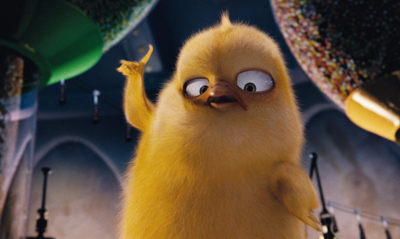 Background Preparation
Background PreparationOnce the "Stuffy Pass" and "Beanbag Shoot" were completed, the background preparation could begin. After a shot (plate) was finished and turned over to R&H, the negative was scanned so that each frame of the key scene now existed in a virtual world. Once complete, a camera helped to create an intricate digital universe that allowed Tim Hill's set to be built again…albeit this time, virtually.
When preparing the background, a team of painters removed any remnants of the placeholder beanbag that was standing in for our fearless rabbit. Once completed, these finished background plates would be married to their respective animated sequences (described in detail below) in a process known as compositing. The end result was that it now looked as if E.B. were fully integrated into the sequence. That equaled the final image and what will be seen by the audience.
Once the initial track was together, many animators were able to work on the multiple aspects of the shot. Explains co-VFX supervisor Mark Rodahl of the multitier approach: "Once you prepare the background for a shot, and once the animation is done, you bring those two pieces together. But you always use the background as a reference, even for animation. They always had this background set, and the artists made sure everything works well for the animation through that camera."
Hop Interview continued
MORE
- Emma Stone Magic in the Moonlight
- Jessica De Gouw Cut Snake
- Maxine Peake Funny Cow
- Denzel The Equalizer 2
- Johnny Flynn Beast
- Logan Marshall Green Upgrade
- Shailene Woodley Adrift
- Eric Toledano and Olivier Nakache C'est La Vie...
- André Leon Talley The Gospel According To André...
- Shakespeare In Tokyo
- Mission: Impossible Fallout
- Glenn Close The Wife
- Allison Chhorn Stanley's Mouth Interview
- Benicio Del Toro Sicario: Day of the Soldado
- Dame Judi Dench Tea With The Dames
- Sandra Bullock Ocean's 8
- Chris Pratt Jurassic World: Fallen Kingdom
- Claudia Sangiorgi Dalimore and Michelle Grace...
- Rachel McAdams Disobedience Interview
- Sebastián Lelio and Alessandro Nivola...
- Perri Cummings Trench Interview



